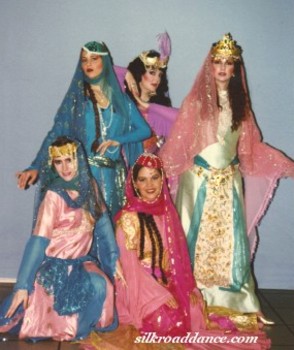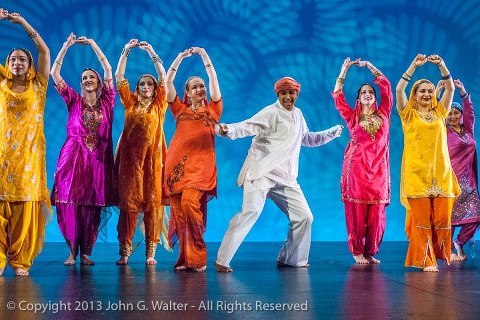
Silk Road Dance Company from an early performance. Nyla, who suggested the name for the ensemble, is shown in green on the far right.
Evoking images of exotic places and treasure-laden caravans, the Silk Road appeals to the popular imagination. Over the past decade, Silk Road cultures have gained new audiences with an increased awareness of the history and geography of the region. Much of the credit for this goes to cellist Yo-Yo Ma and the seeds that were sewn when he launched his Silk Road Project in 1998.
Momentum gathered with the epic 2002 Smithsonian Folklife Festival in Washington DC. This wildly successful event was entitled The Silk Road: Connecting Cultures, Creating Trust and “celebrated the living traditional arts of peoples of Silk Road lands.”
But Silk Road Dance Company®, founded in 1995, traces its roots to an even earlier source of inspiration – a 1982 performance at the Asia Society in New York. Although Laurel Victoria Gray, who later founded the Silk Road Dance Company, did not attend this concert, she learned of it when a fellow graduate student in the PhD program at the University of Washington handed her clipping from that week’s New York Times. It was the October 29, 1982, article by Jennifer Dunning “In Song and Dance Along the Silk Route,” illustrated with a photograph of one of the concert’s female performers.
For Gray, who was already deeply involved in ethnic dance of Central Asia, the Caucasus, and the Middle East, reading the article was a galvanizing moment. “For years I had been searching for descriptors for the dances in my personal repertoire and that of my ensemble,” Gray explains. “All the terms seemed so lengthy and awkward. When I saw the title of the New York Times article, everything came into focus. Of course, I knew about the Great Silk Road, and how it was the connective thread that united these diverse cultures. From that moment on, I began to use the term ‘Silk Road’ to identify my work.”
Gray had fallen in love with Uzbek dance when she met People’s Artist of Uzbekistan Qizlarhon Dusmuhamedova in 1979 and attended her performance with the Bakhor Ensemble at Seattle University. She added Central Asian dance to the growing repertoire of her group which she renamed Tanavar Dance Ensemble in 1982 in honor of a famous genre of Uzbek women’s dances. Soon their concerts and publicity identified them with the cultures of the Silk Road.
Gray returned to Uzbekistan in 1984 as a cultural representative with a Seattle-Tashkent Sister City Delegation led by Mayor Charles Royer. At the invitation of Uzbekistan Vatan Society, Gray traveled to Uzbekistan to continue her dance studies. In 1988 and 1989, Uzbekistan’s Union of Theatrical Workers invited her to bring delegations as part of an ongoing cultural exchange program, causing Gray to identify Seattle as “a new stop on the ancient Silk Road.”
In 1986, Gray released “An Introduction to Uzbek Dance,” the first volume in a proposed “Dances of the Silk Road” video series. New York Times dance critic, Jennifer Dunning, noted that this video “focuses on women’s dance but offers intriguing looks at the basic arm gestures and characteristic movements of the forms as well as the costumes, jewelry and music associated with the dances.”
Later in the 80s, Gray visited New York and was invited to visit the Asia Society by Beate Gordon, who had seen the first volume of Dances of the Silk Road. “It was such an honor,” remembers Gray. “And it also gave me a sense of connecting to an important source of my inspiration.”
When Gray left Seattle in 1992 to continue her dance studies in Uzbekistan for two years, Tanavar Dance Ensemble gave a few more performances but waited for Gray’s return. She did come back to Seattle for several months before relocating to the East Coast in the summer of 1994.
As Gray began to meet and work with Washington DC area dancers, a small core of students expressed an interest in exploring Central Asian and Persian dance in greater depth. And when the dancer Nyla approached her about performing for Persian weddings, Gray saw the opportunity to create a Washington DC-based performance group.
Soon auditions were held and students began to learn Gray’s repertoire. They also gathered to work on building more costumes. Gray brought several of the Tanavar Dance Ensemble costumes with her from Seattle, but needed new ones for additional choreographies.
But what to name the group? Gray considered reviving the name Tanavar since the Seattle group was inactive, but it was Nyla who made the fateful suggestion. Laurel recalls the moment. Nyla said “you are always talking about the Silk Road, so why don’t you call us ‘Silk Road?”’
And Nyla was right so, in 1995, Silk Road Dance Company was born.
The tiny group graduated from weddings to their first public concert – “Persian Night”- held on February 6, 1996. By 2001, Silk Road Dance Company made it to the Kennedy Center stage for the first time.
The ensemble’s continued success convinced Gray to register “Silk Road Dance Company” as a trademark, which was accomplished thanks to a student who was also an attorney and arranged for her firm to help on a pro bono basis. The process proved to be a time-consuming task, but fortunately Gray’s academic training in history taught her to save documentation, helping to prove their long existence. In 2005, the the United States Patent and Trademark Office issued a Certificate of Trademark Registration to this organization for the mark “Silk Road Dance Company (R).”
It has been an exciting journey but it is one that is far from over. Silk Road Dance Company® has performed in 15 different states and also in four foreign countries, at the invitation and expense of celebrated hosts.
“So many events converged to make this all happen,” reflects Gray. “From my first meeting with Qizlarhon to the New York Times article, from my move from Seattle to Washington DC, to my student who facilitated our trademark – all these things look like kismet.
Yes, it must be kismet. Fate.










